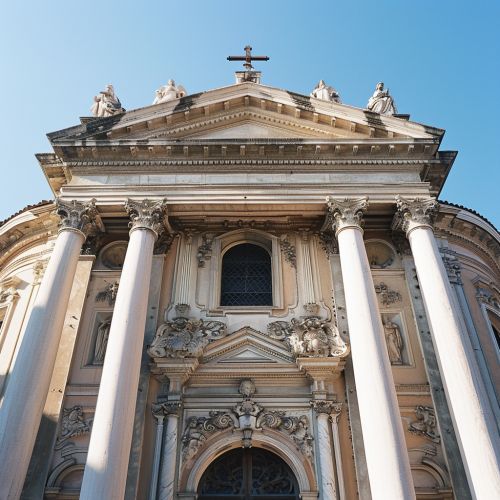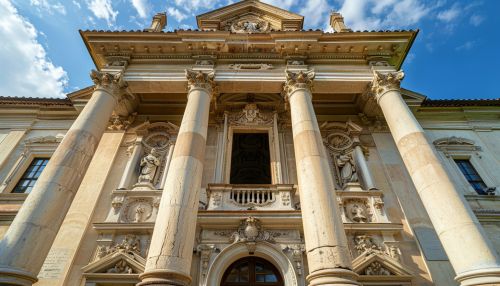Church of St. Charles Borromeo, Vienna
History
The Church of St. Charles Borromeo, commonly known as Karlskirche, is a baroque church located on the south side of Karlsplatz in Vienna, Austria. The church was commissioned by Emperor Charles VI in 1713 in response to a vow he made during the plague epidemic that struck Vienna in 1713. The church is dedicated to Charles Borromeo, a saint revered for his efforts in counter-reformation and his work with plague victims.
Construction began in 1716 under the direction of the architect Johann Bernhard Fischer von Erlach. After Fischer von Erlach's death in 1723, his son, Joseph Emanuel Fischer von Erlach, took over the project, completing the church in 1737. The church's design is a synthesis of various architectural styles, including ancient Greek and Roman, Renaissance, and contemporary Baroque.
Architecture
The architecture of the Church of St. Charles Borromeo is a prime example of the Baroque style, characterized by grandeur, drama, and movement. The church's facade features a portico with six columns, reminiscent of a Greek temple. The two flanking columns are inspired by Trajan's Column in Rome and are adorned with reliefs depicting scenes from the life of St. Charles Borromeo.


The central dome, which reaches a height of 72 meters, is a dominant feature of the church's exterior. The dome is crowned with a lantern and a golden cross. The interior of the dome is adorned with frescoes by Johann Michael Rottmayr, depicting the apotheosis of St. Charles Borromeo.
The church's interior is equally impressive, with a high altar designed by Fischer von Erlach. The altar features a statue of St. Charles Borromeo ascending to heaven, surrounded by angels and clouds. The side chapels are decorated with altarpieces and sculptures by various artists, including Paul Troger and Lorenzo Mattielli.
Symbolism
The Church of St. Charles Borromeo is rich in symbolic elements. The two flanking columns symbolize the Old and New Testaments, while the central dome represents the unity of the Christian faith. The reliefs on the columns depict scenes from the life of St. Charles Borromeo, emphasizing his role as a reformer and healer.
The high altar's design, with St. Charles Borromeo ascending to heaven, symbolizes the saint's intercession on behalf of the faithful. The use of light and shadow in the church's interior creates a sense of divine presence, enhancing the spiritual experience of the visitors.
Art and Decoration
The Church of St. Charles Borromeo houses numerous works of art, including frescoes, sculptures, and altarpieces. The frescoes in the dome, painted by Johann Michael Rottmayr, are considered masterpieces of Baroque art. They depict the apotheosis of St. Charles Borromeo, with the saint surrounded by angels and saints.
The high altar, designed by Fischer von Erlach, is a focal point of the church's interior. It features a statue of St. Charles Borromeo ascending to heaven, surrounded by angels and clouds. The side chapels are decorated with altarpieces and sculptures by various artists, including Paul Troger and Lorenzo Mattielli.
Influence and Legacy
The Church of St. Charles Borromeo has had a significant influence on the development of Baroque architecture in Vienna and beyond. Its innovative design, combining elements of ancient Greek and Roman architecture with contemporary Baroque, set a precedent for future church designs.
The church's dedication to St. Charles Borromeo, a key figure in the Counter-Reformation, underscores its role as a symbol of Catholic renewal and reform. The church continues to be a place of worship and a popular tourist attraction, drawing visitors from around the world.
